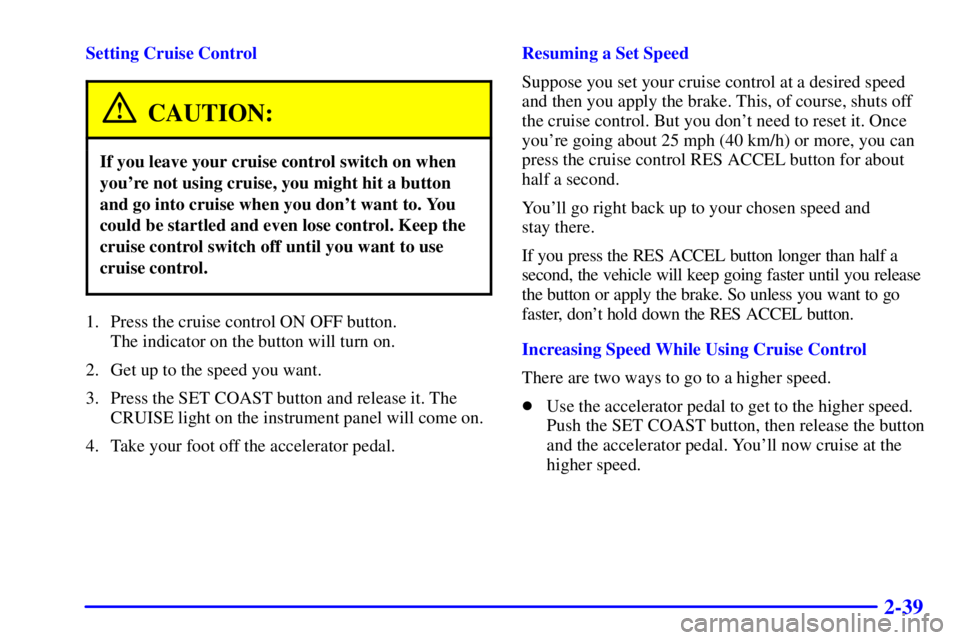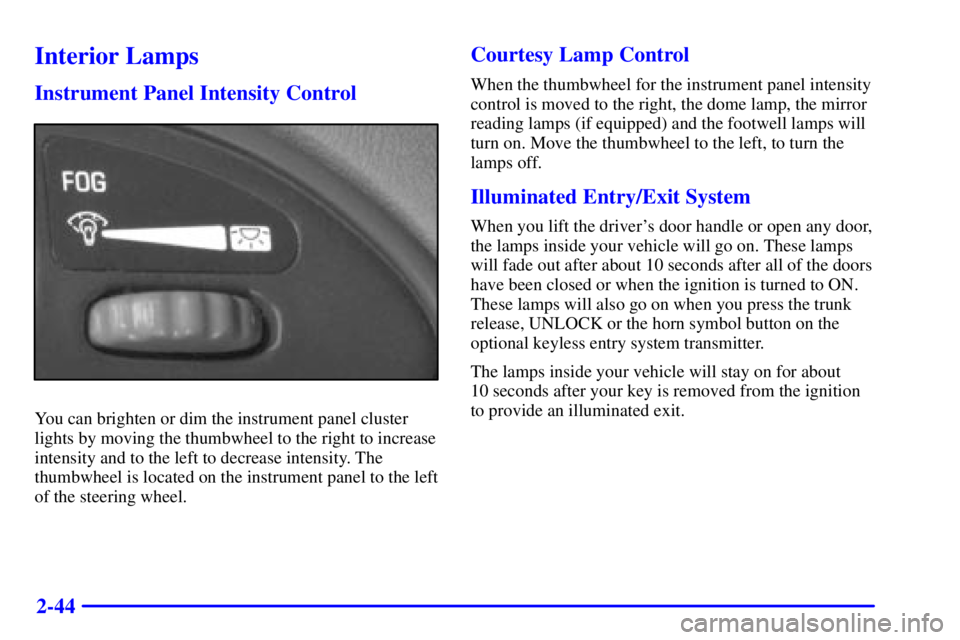Page 78 of 318

2-13
CAUTION:
It can be dangerous to drive with the trunk lid
open because carbon monoxide (CO) gas can
come into your vehicle. You can't see or smell
CO. It can cause unconsciousness and even death.
If you must drive with the trunk lid open or if
electrical wiring or other cable connections must
pass through the seal between the body and the
trunk lid:
�Make sure all other windows are shut.
�Turn the fan on your heating or cooling
system to its highest speed with the setting
on VENT. That will force outside air into
your vehicle. See ªComfort Controlsº in
the Index.
�If you have air outlets on or under the
instrument panel, open them all the way.
See ªEngine Exhaustº in the Index.
Remote Trunk Release
The remote trunk release button is located on the
driver's door. Push the remote release button to release
the trunk lid. Make sure the remote trunk lockout release
feature is not activated.
The trunk will unlock when the remote trunk release
button is pressed, the remote trunk release lockout is to
OFF and the ignition is to ON, while the shifter is to
PARK (P) or the parking brake is engaged or the
ignition is to OFF.
Page 82 of 318

2-17
ACC (Accessory) (B): This position unlocks the
transaxle. It also lets you use things like the radio and
windshield wipers when the engine is not running. To
use ACC, turn the key clockwise to the first position.
Use this position if your vehicle must be pushed or
towed, but never try to push
-start your vehicle.
ON (C): This position is where the key returns after
you start your engine and release the switch. The switch
stays in ON when the engine is running. But even when
the engine is not running, you can use ON to operate
your electrical power accessories and to display some
instrument panel warning lights.
START (D): This position starts the engine. When the
engine starts, release the key. The ignition switch will
return to ON for normal driving.
NOTICE:
If your key seems stuck in OFF and you can't
turn it, be sure you are using the correct key; if
so, is it all the way in? Turn the key only with
your hand. Using a tool to force it could break
the key or the ignition switch. If none of this
works, then your vehicle needs service.
Starting Your Engine
Automatic Transaxle
Move your shift lever to PARK (P) or NEUTRAL (N).
Your engine won't start in any other position
-- that's a
safety feature. To restart when you're already moving,
use NEUTRAL (N) only.
NOTICE:
Don't try to shift to PARK (P) if your vehicle
is moving. If you do, you could damage the
transaxle. Shift to PARK (P) only when your
vehicle is stopped.
Manual Transaxle
The gear selector should be in NEUTRAL and the
parking brake engaged. Hold the clutch pedal to the
floor and start the engine. Your vehicle won't start
if the clutch pedal is not all the way down
-- that's a
safety feature.
Page 100 of 318

2-35 Turn and Lane Change Signals
The turn signal has two upward (for right) and two
downward (for left) positions. These positions allow you
to signal a turn or a lane change.
To signal a turn, move the lever all the way up or
down. When the turn is finished, the lever will
return automatically.
An arrow on the instrument
panel cluster will flash in
the direction of the turn or
lane change.
To signal a lane change, just raise or lower the lever
until the arrow starts to flash. Hold it there until you
complete your lane change. The lever will return by
itself when you release it.
As you signal a turn or a lane change, if the arrows flash
rapidly, a signal bulb may be burned out and other
drivers won't see your turn signal.If a bulb is burned out, replace it to help avoid an
accident. If the arrows don't go on at all when you
signal a turn, check for burned
-out bulbs and then check
the fuse (see ªFuses and Circuit Breakersº in the Index).
Headlamp High/Low Beam Changer
To change the headlamps
from low beam to high
beam, push forward
on the turn signal/
multifunction lever.
To change the headlamps from high beam to low beam,
pull the turn signal lever backward. If the ignition is on
and the high beams are on, a light on the instrument
panel cluster also will be on.
Flash-to-Pass
This feature lets you use your high-beam headlamps to
signal a driver in front of you that you want to pass.
To use it, pull the turn signal/multifunction lever toward
you until the high
-beam headlamps come on, then
release the lever to turn them off.
Page 104 of 318

2-39
Setting Cruise Control
CAUTION:
If you leave your cruise control switch on when
you're not using cruise, you might hit a button
and go into cruise when you don't want to. You
could be startled and even lose control. Keep the
cruise control switch off until you want to use
cruise control.
1. Press the cruise control ON OFF button.
The indicator on the button will turn on.
2. Get up to the speed you want.
3. Press the SET COAST button and release it. The
CRUISE light on the instrument panel will come on.
4. Take your foot off the accelerator pedal.Resuming a Set Speed
Suppose you set your cruise control at a desired speed
and then you apply the brake. This, of course, shuts off
the cruise control. But you don't need to reset it. Once
you're going about 25 mph (40 km/h) or more, you can
press the cruise control RES ACCEL button for about
half a second.
You'll go right back up to your chosen speed and
stay there.
If you press the RES ACCEL button longer than half a
second, the vehicle will keep going faster until you release
the button or apply the brake. So unless you want to go
faster, don't hold down the RES ACCEL button.
Increasing Speed While Using Cruise Control
There are two ways to go to a higher speed.
�Use the accelerator pedal to get to the higher speed.
Push the SET COAST button, then release the button
and the accelerator pedal. You'll now cruise at the
higher speed.
Page 106 of 318
2-41
Exterior Lamps
Turn the turn signal lever end cap up one position to
turn on your:
�Parking Lamps
�Side Marker Lamps
�Taillamps
�License Plate Lamps
�Instrument Panel LightsTurn the turn signal lever end cap up two positions to
turn on your:
�Headlamps
�Parking Lamps
�Sidemarker Lamps
�Taillamps
�License Plate Lamps
�Instrument Panel Lights
Turn the switch to OFF to turn all of the lamps off.
Lamps On Reminder
If you turn off the ignition and open the driver's door while
leaving the lamps on, you will hear a warning chime.
Page 107 of 318

2-42 Daytime Running Lamps
Daytime Running Lamps (DRL) can make it easier
for others to see the front of your vehicle during the
day. DRL can be helpful in many different driving
conditions, but they can be especially helpful in the
short periods after dawn and before sunset.
The DRL system will make your high
-beam headlamps
come on at a reduced brightness when:
�The ignition is on,
�the headlamp switch is in OFF or you have turned on
your parking lamps,
�the light sensor detects daytime light,
�the parking brake is released and
�the shift lever is not in PARK (P) on vehicles with an
automatic transaxle.When the DRL system is on, the taillamps, sidemarker
lamps, park lamps and instrument panel lights will not
be illuminated.
As with any vehicle, you should turn on the regular
headlamp system when you need it.Automatic Light Control (ALC)
When it is dark enough outside, your Automatic Light
Control (ALC) will turn on your headlamps along with
other lamps such as the taillamps, sidemarker lamps,
park lamps and the instrument panel lights. The radio
lights will also be dim.
Your vehicle is equipped with a light sensor on the top
of the instrument panel under the defroster grill, so be
sure it is not covered. This will cause the ALC system to
be on whenever the ignition is on.
The ALC system may also come on when driving
through a parking garage, heavy overcast weather or a
tunnel. This is normal.
Page 108 of 318

2-43
There is a delay in the transition between the daytime
and nighttime operation of the DRL and the ALC
systems so that driving under bridges or bright overhead
street lights does not affect the system. The DRL and
ALC systems will only be affected when the light sensor
sees a change in lighting lasting longer than this delay.
To idle your vehicle with the ALC system off, set the
parking brake while the ignition is off. Then start the
vehicle. The ALC system will stay off until you release
the parking brake.
As with any vehicle, you should turn on the regular
headlamp system when you need it.
Delayed Headlamps
The delayed headlamps feature will continue to
illuminate the headlamps for 20 seconds after the key is
turned to OFF then the headlamps will automatically
turn off.
To override the 20 second delayed headlamp feature,
while it is active turn the turn signal/multifunction lever
end cap up one position and back to OFF.
Fog Lamps
The button for your fog
lamps is located on the
instrument panel, to the left
of the steering wheel, beside
the instrument panel
intensity control.
When using the fog lamps, the ignition must be on as
well as the parking lamps or the low
-beam headlamps.
Push the button to turn the fog lamps on. An indicator
light on the button will glow when the fog lamps are on.
Push the button again to turn the fog lamps off.
The fog lamps will turn off whenever the high
-beam
headlamps are turned on. When the high beams are
turned off, the fog lamps will come on again.
Page 109 of 318

2-44
Interior Lamps
Instrument Panel Intensity Control
You can brighten or dim the instrument panel cluster
lights by moving the thumbwheel to the right to increase
intensity and to the left to decrease intensity. The
thumbwheel is located on the instrument panel to the left
of the steering wheel.
Courtesy Lamp Control
When the thumbwheel for the instrument panel intensity
control is moved to the right, the dome lamp, the mirror
reading lamps (if equipped) and the footwell lamps will
turn on. Move the thumbwheel to the left, to turn the
lamps off.
Illuminated Entry/Exit System
When you lift the driver's door handle or open any door,
the lamps inside your vehicle will go on. These lamps
will fade out after about 10 seconds after all of the doors
have been closed or when the ignition is turned to ON.
These lamps will also go on when you press the trunk
release, UNLOCK or the horn symbol button on the
optional keyless entry system transmitter.
The lamps inside your vehicle will stay on for about
10 seconds after your key is removed from the ignition
to provide an illuminated exit.